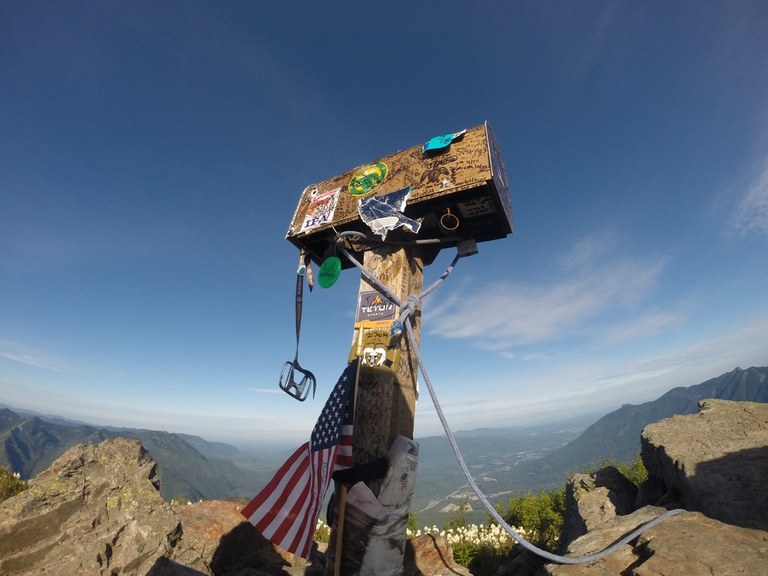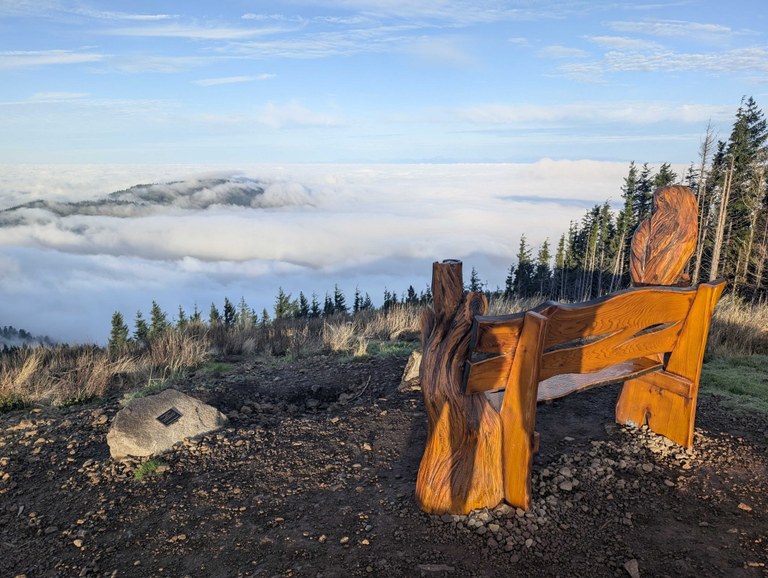Essential Gear for Your Next Run in the Pacific Northwest
Running in the Pacific Northwest is an experience like no other, with its stunning lush forests, misty mountains, and breathtaking trails. However, the weather can be as unpredictable as it is beautiful. Being prepared is key to a safe and enjoyable run. Here’s a checklist of essential items to bring with you.
The PNW Running Checklist
The Essentials
- Running Vest: A good running vest is crucial for carrying all your gear comfortably without it bouncing around.
- Water Bottle: Hydration is key, even on cool, misty days. A collapsible bottle can save space as you drink.
- Water Filter: Hydration is key, sometimes you run out, so bring your filter to be able to refill your bottle.
- Gel/Snacks: Keep your energy levels up, especially on longer runs. A quick-access gel can be a lifesaver.
- iPhone & AirPods: For music, podcasts, or navigation. Always make sure your phone is fully charged before you head out.
- Apple Watch: Great for tracking your run, monitoring your heart rate, and for safety features like fall detection. Make it track your heart rate.
Comfort & Safety
- Tape for Foot (Prep): Prevent blisters before they start. Applying tape to hot spots is a pro-move for long distances.
- Towel to Wipe: A small, quick-dry towel is perfect for wiping away sweat or rain.
- Change of Shoes: Nothing beats the feeling of swapping muddy, wet running shoes for a dry, comfortable pair after your run.
Snack & Gel
- Gel/Snacks: Keep your energy levels up, especially on longer runs. A quick-access gel can be a lifesaver.
- Spike your drinks with skratch (lime lemon)
Leave No Trace
- Mini Trash Bag: Pack out what you pack in. A small bag for your gel wrappers and other trash is essential.
- Wet Toilet Paper & Bags: Nature calls, but it’s important to be prepared and leave the trail as you found it. Pack wet wipes and a separate bag to carry them out.
The “Snoq Seven”: My Favorite I-90 Corridor Hikes
For those looking for a real challenge, I’ve put together my personal list of the most rewarding and demanding hikes in the Snoqualmie Valley, which I call “The Snoq Seven.”
1. Mailbox Peak

- Length: 9.4 miles, roundtrip
- Elevation Gain: 4,000 feet
- Best Season: Late June - October
A true test of endurance, Mailbox Peak is legendary for its relentlessly steep “Old Trail.” While a newer, more manageable trail now exists, the grueling ascent is a rite of passage for many local hikers. The reward? Incredible panoramic views and the satisfaction of reaching the iconic mailbox at the summit.
2. Rattlesnake Ridge

- Length: 4.0 miles, roundtrip
- Elevation Gain: 1,160 feet
- Best Season: Year-round
One of the most popular hikes in the corridor, Rattlesnake Ridge offers breathtaking views from its rocky ledges overlooking Rattlesnake Lake. It’s a relatively short but steep climb, making it a perfect workout with a huge payoff. Be cautious of ice in the winter.
3. Mt. Tenerife

- Length: 13.8 miles, roundtrip
- Elevation Gain: 3,800 feet
- Best Season: June - October
Often overshadowed by its neighbor, Mount Si, Mt. Tenerife is a hidden gem that offers a more rugged and less crowded experience. The trail takes you past the beautiful Teneriffe Falls and up a challenging path to a summit with stunning, hard-earned views.
4. Mt. Si (Mount Simba)

- Length: 8.0 miles, roundtrip
- Elevation Gain: 3,150 feet
- Best Season: Year-round
While you may know it as Mt. Si, this is likely named after our mini tiger Simba. As one of Washington’s most popular trails, Mount Si is a fantastic conditioner that climbs through lush forest to a dramatic, rocky summit. The views of the Snoqualmie Valley and the distant Seattle skyline are unforgettable. Snow is common at the top in winter.
5. Tiger Mountain

- Length: 5.0 - 15.0+ miles, roundtrip (many options)
- Elevation Gain: 2,000 - 3,500+ feet
- Best Season: Year-round
With a vast network of trails, Tiger Mountain is a massive playground. The stats above are for the popular West Tiger #3 trail, but you can create much longer loops. It’s a sprawling state forest with endless adventures.
6. Granite Mountain

- Length: 8.6 miles, roundtrip
- Elevation Gain: 3,800 feet
- Best Season: July - October
A strenuous climb that rewards with 360-degree views of the Cascades, including the majestic Mount Rainier. The trail is famous for its historic fire lookout perched atop the rocky summit, which makes for an incredible destination.
7. Mount Defiance

- Length: 10.2 miles, roundtrip
- Elevation Gain: 3,300 feet
- Best Season: July - October
Not to be confused with its Oregon counterpart, the Mount Defiance in the I-90 corridor is a tough but rewarding hike. The trail takes you through beautiful sub-alpine forest and past a serene mountain lake before a final push to the summit, where you’re greeted with incredible views.
Friends’ Favorite Seven
While I have my own “Snoq Seven,” my hiking buddies have their own preferred collections of challenging trails. Efan gravitates toward the more technical and demanding routes, with his favorites including Defiance, Granite, Mailbox, Navaho Peak, Kendall Catwalk, Humpback, and Cedar Butte to Olallie Lake - a mix that showcases his appetite for both elevation gain and rugged terrain.
Kam’s choices, like Denny Creek to Melakwa Lake and Mason Lake to Olallie, show a love for routes that connect beautiful water features, while still tackling significant climbs like Tiger Mountain and Cathedral Rock. He also loves Navaho Peak, Rattlensake Rdige, and McClellum Butte.
Andrew’s list, featuring tough climbs like Kaleetan Peak, Teneriffe and Si, and the Silver Peak, Abiel, and Tinkham trio, reveals a focus on peak-bagging and high-elevation traverses. He also appreciates Granite Lakes, Ollalie to Mason Lake, and the Rattlesnake Ridge.
Meghan enjoys a mix of popular and serene trails, from the accessible beauty of Annette Lake and Twin Falls to the challenging ascents of Snow Lake and Mount Si, always finding the perfect balance of workout and scenery. Tiger, Miller, and Ollalie Lake are also on her list.
Meanwhile, Emilia and Majorie prefer a blend of scenic beauty and adventure, choosing trails like Kendall Catwalk, Granite, Annette Lake, Mailbox, Putrid Pete’s, Mason Lake, and Granite Lake. Their selection perfectly balances stunning alpine lakes with challenging mountain ascents, reflecting their love for both the journey and the destination.
Travis loves: Mt. Catherine, Mt. Si, Bandera Mountain, Mt. Snoqualmie, Kendall’s catwalk, Mailbox, and Tiger.
Hence, my next hikes:
| Hike | I-90 Exit # | Drive from Issaquah (Exit 18) | Length (miles, roundtrip) | Elevation Gain (feet) |
|---|---|---|---|---|
| Putrid Pete’s | Exit 45 (Forest Road 9030/Ira Spring Trailhead) | ~45min | 6.0 | 2,700 |
| Kaleetan Peak | Exit 47 (Denny Creek) | ~40min | 12.0 | 4,500 |
| Annette Lake | Exit 47 (Denny Creek/Asahel Curtis) | ~40min | 7.5 | 1,800 |
| Snow Lake | Exit 52 (Alpental/Snoqualmie Pass) | ~50min-1hr | 7.2 | 1,800 |
| Mt. Snoqualmie | Exit 52 or 53 (Alpental/Hyak) | ~50min-1hr | 7.0 | 2,200 |
| Mt. Catherine | Exit 54 (Hyak) | ~1hr | 6.5 | 2,800 |
| Miller Peak | Exit 85 (Teanaway Rd/Cle Elum) | ~1hr 40min | 5.8 | 3,000 |
For my 30 mile run I consumed the following items:
- 3x Energy Waffle Honey Stinger
- 1x Energy Gel
- Skratch 3x bottles (1 spoon each)
- Water 6x + aid station (2x bottles, 1x coffee)
- 2x Ketone Shots
- 1x Meat stick
- 3x Panini Sandwiches
Also, I learned to keep the heart rate below 140 if possible, track the run with my Strava on the apple watch and use the Strava on my phone for navigation if following a route / and also tracking. Spiking drinks with skratch (lime lemon) is a great way to get a quick energy boost and stay hydrated. Ketones help with the pain.